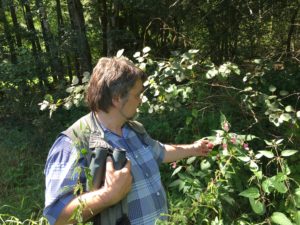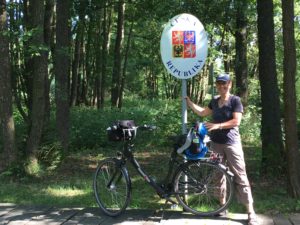For me, this has been a year of discovering small, almost hidden treasures: Rare birds, small towns, bobcats, mystery wetlands – off the beaten path and yet, right in the middle of Germany. I encountered these treasures on my expedition along and around the strip of land that once ran through the landscape like an ugly scar – the former border between East and West Germany. The fact that black stork, bobcats, and some 1,200 other rare animal and plant species can survive in this strip of land is no coincidence – it is largely thanks to the work and inspiration of one person by the name of Kai Frobel. In short, as a school boy Kai kept noticing an unusual number of rare bird species

along the border; documented his observations; won first prize in a science contest, and – as soon as the Berlin Wall fell and the border opened – prepared a resolution to declare the border strip a nature preserve – Germany’s Green Belt. Kai (now Dr. Frobel) is one of the people I met during my expedition and to whom I am grateful this year, for their work and for sharing their stories with me.
In contrast to the black stork Kai spied during our walk in the Green Belt, Berlin’s Brandenburg Gate is not exactly a hidden treasure. It sits in the middle of Berlin like the Arc de Triomphe in Paris, except that you can’t drive around it. And while I tend to be wary of triumphant architecture, I have to say that the Brandenburg Gate is one of my favorite places in Berlin, simply because I – like anyone else – can walk around it, and through it. After the Berlin Wall was built in 1961, the Gate stood in the heavily fortified no man’s land between the two halves of the city (which belonged to two separate nations and political spheres) and no one could walk through it for the next 28 years. If you were alive and past toddler age on November 9, 1989, you will remember images of ecstatic people dancing on top of the Berlin Wall, with the Brandenburg Gate in the background.
I happened upon this light installation one evening a few weeks after I finished my expedition along the Green Belt. I was walking along Unter den Linden boulevard, approaching Brandenburg Gate from the east, holding opposing thoughts and feelings in my mind: On the one hand, the goose bumps I have felt ever since I walked through the Gate for the first time; on the other hand, awareness of the divisions that still exist between East and West Germans.
Then the light show started, with the words “Berlin knows how to do freedom” appearing on a banner at the top of Brandenburg Gate. It was easy to let go of the conversation in my head and let myself be pulled into the artistic reminder of the Peaceful Revolution, along with the hundreds of people around me.
The question of what continues to divide Germans is still on my mind. Despite the unique story of the border and reunification, I sense parallels with divisions in my “other” country, the United States. The divisions seem to have to do with feelings, on the part of a good chunk of each country’s population, of not being heard or respected – and corresponding feelings of exasperation on the part of another good portion of the population with the first group. I started to get clearer about this about half-way through my expedition, and set an intention to make this more of a focus in my remaining research.
Out of all this grew two new year’s resolutions, which I happily offer to anyone who has not gotten around to formulating their own yet:
- Let us take note of and appreciate the good news stories, because they do exist (hint: the fall of the Berlin Wall, the opening of the border, the work of Kai Frobel, … you fill in the stories you know).
- Let us all work on our listening skills, keeping in mind that listening is an active thing we do. Let us pretend we are anthropologists, curious about someone from another culture, even with someone we know. Chances are this will increase the likelihood that someone will listen to us, too. As meditation teacher Sakyong Mipham Rinpoche says with a twinkle in the eye, “Listening is the price we pay if we want to be heard”.
Thank you to all of you who have traveled along with me in spirit and supported my journey in various ways. If you made a donation this year, please know that yesterday I transferred $160 to BUND, the organization that oversees the Green Belt and works toward closing the remaining gaps through land purchases.
In the next few months, the intervals between my postings will likely be longer as I focus on background research, more site visits and interviews, and the book. Feel free to still comment on or ask questions about things I’ve written – I’m always glad to know that people are reading along, and what they’re interested in! I will be writing about the other inspiring people I met in the course of my expedition, like Christine Bardin, the mayor of a small town on the eastern side of the former border; the former border guards from East and West who come together regularly to process their experiences from opposite sides of the border; and residents of the tiny border village that declared itself an independent republic the night before the Berlin Wall fell (which of course neither they nor anyone else could know).
Warm wishes for a new year full of treasures, large or small,
Kerstin


Amen to “remembering the good news stories” and the artistic reminder of the Peaceful Revolution! Keep up the excellent work Kerstin!
I thoroughly enjoyed reading this post! Thank you for sharing this amazing experience!
Good news story….
….that you, Kerstin, picked up the Green Belt and made it your project which finally will be for our benefit. Good Luck in 2018!
Yes! Good news — there is some — we just don’t generally see it in the press. Thanks, Kerstin.
Happy New Year to you, Kerstin. And thank you for the reminder of keeping the good news stories in the fronts of our minds. A year’s news cycle can certainly feel like a “trash fire” as the late-night comics say, but that’s not necessarily the frame we need to accept.